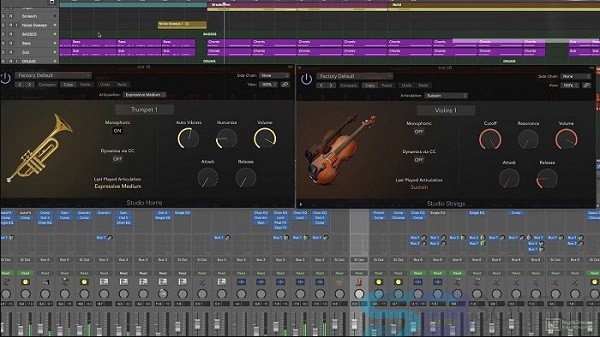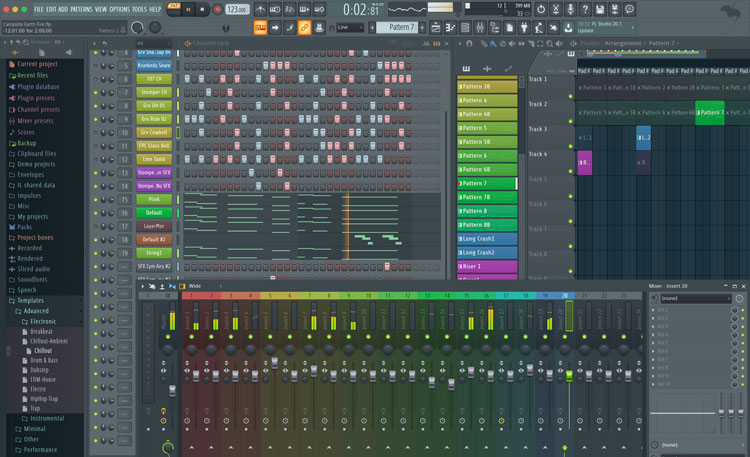
1. Sophisticated creative tools for professional songwriting, beat making, editing, and mixing are built around a modern interface that’s designed to get results quickly and also deliver more power whenever it’s needed.
- Electrical Engineering questions and answers. 10 For the logic function f (a,b,c,d) = Em (0,1,2,6,7,8,9,14), (a) Find the prime implicants using the Quine-McCluskey method. (b) Find all minimum sum-of-products solutions using the Quine-McCluskey method.
- One-click Logic arrangement tricks – insert paste, repeat, more One-click solutions to naming regions in Logic, color coding, more Organize your workflow with the Logic Plug-in Link system.
- A technical support community for Apple Logic Pro users.
View Homework Help - hw 10 logic.docx from PHI 1010 at University of North Carolina, Pembroke. Madison Oxendine-Dial Professor Bass PHI-1010-800 HW 10: 7.2, all Part A: True or False?

2. Logic Pro includes a massive collection of instruments, effects, loops and samples, providing a complete toolkit to create amazing-sounding music.
Features and Description
Key Features
Latest Version: 10.6.3
What does Logic Pro do? Logic Pro is the most advanced version of Logic ever. Sophisticated creative tools for professional songwriting, beat making, editing, and mixing are built around a modern interface that’s designed to get results quickly and also deliver more power whenever it’s needed. Logic Pro includes a massive collection of instruments, effects, loops and samples, providing a complete toolkit to create amazing-sounding music.Professional Music Production• Record and edit MIDI or audio using a comprehensive set of editors and tools • Keep takes organized with take folders and build comps quickly with Quick Swipe Comping• Track Alternatives let you create and switch between different playlists of regions and edits on a track• Fix out-of-tune vocals and change the melodies of recorded audio with Flex Pitch• Manipulate the timing and tempo of any recording with ease using Flex Time• Use Smart Tempo to import audio and have it automatically conform to your project BPM• Comprehensive mix and plug-in parameter automation can be part of a region or track • Perform and mix from anywhere in the room using Logic Remote on iPad or iPhone• Produce simple lead sheets or orchestral scores with built-in Score editor Drum Production and Beat Making• Use Drum Machine Designer to build and perform your own custom kits• Program beats, bass lines and melodic parts using Step Sequencer• Create authentic acoustic, electronic, or hip-hop drum tracks using Drummer, a virtual session player and beat producer• Choose among 33 distinct drummers that can take your direction and perform millions of unique groovesSampling• Use Sampler to quickly create and edit sophisticated multi-sampled instruments• Import a single audio file or record directly into Quick Sampler to instantly build a playable instrumentKeyboards and Synths• Get inspired by collection of synths that provide analog, wavetable, FM, additive, granular, spectral, and modeling synthesis• Quickly find sounds or create unique new ones with Alchemy, a powerful sample manipulation synthesizer• Instantly turn a simple chord into a rich performance with the Arpeggiator • Transform simple ideas into elaborate performances using nine MIDI plug-ins• Play faithful models of classic organs, keyboards, and vintage synths Guitar and Bass Gear• Build your own guitar or bass rig with Amp Designer using vintage and modern amps, cabinets, and mics• Design a custom Pedalboard from a collection of delay, distortion, and modulation stompboxesCreative and Production Effects• Access a professional collection of vintage and modern delays, EQs and compressors• Play your sounds through a variety of realistic acoustic spaces or creative synthesized reverbs • Add movement to your tracks with a variety of modulation effects Sound Library • Over 4,300 instrument and effect patches• 1,800 meticulously sampled instruments• More than 10,000 Apple Loops in wide range of genresCompatibility• Expand your instrument and effects library with third-party Audio Units-compatible plug-ins• Share to GarageBand option allows you to remotely add new tracks to your Logic project from your iPhone or iPad via iCloud• Import and export XML to support Final Cut Pro workflows• Export and share your songs directly to SoundCloud • Open projects from Logic 5 or laterStorage Requirements6GB available storage space for minimum install / 72GB storage space for full Sound Library installation
 Download for MacOS - server 1 --> $199.99
Download for MacOS - server 1 --> $199.99Download Latest Version

Download and Install Logic Pro
Download for PC - server 1 -->MAC:
Download for MacOS - server 1 --> $199.99
Logic 7
Thank you for visiting our site. Have a nice day!More apps by Apple
When recording audio or playing a software instrument in Logic Pro, you might experience a slight delay between playing or singing a note and when you hear the sound from your speakers or headphones. This delay is called input monitoring latency. A variety of factors contribute to input monitoring latency, including:
- The input and output (I/O) buffer size setting in Logic Pro
- The analog-to-digital (A/D) and digital-to-analog (D/A) conversion processes
- Any audio interface software that you're using
- The sample rate of your project
- Plug-ins inserted on tracks in your project
Though you can’t change the amount of input monitoring latency produced by the A/D and D/A conversion processes or by your audio interface’s software, you can set the sample rate of your project and adjust the I/O buffer size to minimize latency. You can also manage latency caused by plug-ins using Low Latency Mode while recording.
Set the sample rate of your project
Set the sample rate for your project when you first create it. Higher sample rates result in less input monitoring latency. However, projects with higher sample rates create larger audio files, which can increase the load on the processor and the disk of your Mac. Plug-ins also require more processing power at higher sample rates.
Adjust the I/O buffer size
The I/O buffers temporarily store some of the incoming and outgoing audio data to protect against audible dropouts, clicks, or pops. You can change the I/O buffer size at any time to minimize latency.
In Logic Pro, smaller I/O buffer sizes reduce input monitoring latency. However, smaller buffer sizes require more processing power, which can cause system overload alerts. Larger I/O buffer sizes require less processing power, but increase latency.
When recording, set the I/O buffer to the lowest setting. If you encounter system overload alerts, increase the I/O buffer size to the next setting. Projects with many tracks or a lot of software instruments require higher I/O buffer sizes, depending on the amount or RAM and the speed of the processor in your Mac.
Here's how to change the I/O buffer size:
- Choose Logic Pro > Preferences, then click Audio.
- Click Devices.
- Choose the buffer size from the I/O Buffer Size pop-up menu.
Logic Pro shows the resulting latency under the I/O Buffer Size menu. Roundtrip latency is the total amount of input monitoring latency you'll experience from audio input to audio output.
Logic 10
Turn Low Latency Mode on to manage plug-in latency
Certain plug-ins can contribute to input monitoring latency, particularly dynamics plug-ins with look-ahead functions. If you're using these kinds of plug-ins in a project, you can minimize the latency they produce while recording using Low Latency Mode.
Low Latency Mode bypasses plug-ins as needed, so the amount of latency doesn't exceed the Limit setting in the Plug-in Latency section of the General Audio preferences of Logic Pro. Low latency mode is especially useful when you want to record a software instrument in a project that includes latency-inducing plug-ins.
Logic 7 System
To turn Low Latency Mode on, choose Record > Low Latency Mode.